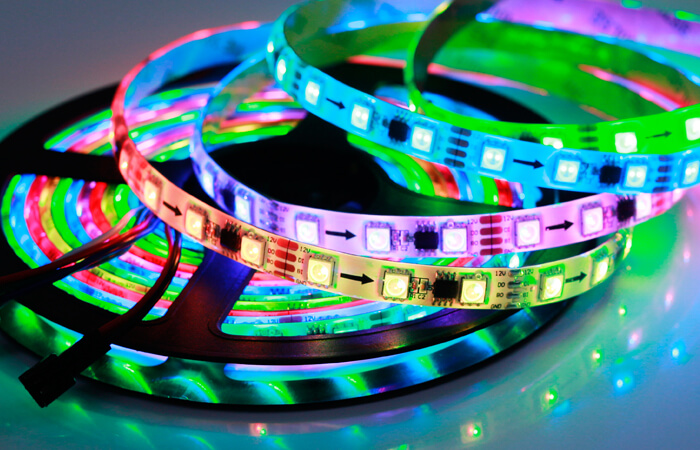5 Things to Know Before Buying LED Strip Lights in Bulk

With the ever-growing demand for energy-efficient, stylish, and smart lighting solutions, wholesale LED strip lights have emerged as one of the most popular choices for both commercial and residential projects. Whether you’re a retailer, contractor, interior designer, or event planner, buying LED strip lights in bulk can lead to substantial savings and long-term value.
However, bulk purchasing isn’t as simple as clicking “add to cart” and choosing the cheapest option. To avoid costly mistakes and ensure you’re getting high-quality products that suit your needs, there are key factors you must consider.
In this guide, we’ll share the 5 most important things to know before buying LED strip lights in bulk, so you can make a confident, informed investment.
1. Understand LED Strip Specifications
Before purchasing LED strip lights in bulk, you need to fully understand their technical specifications, as not all LED strips are created equal. Here are the core specs to look at:
-
Voltage (12V vs. 24V): 12V is common for smaller projects, while 24V is better for longer runs and consistent brightness over distance.
-
LED Density (e.g., 30, 60, 120 LEDs per meter): Higher density = brighter light but also more heat and higher power consumption.
-
Color Temperature: Warm white (~2700K), cool white (~6000K), RGB (color-changing), RGBW (RGB + white), or tunable white.
-
IP Rating: For water resistance. IP20 for indoor dry areas, IP65/IP67/IP68 for kitchens, bathrooms, or outdoor use.
-
Dimming Capability: Some strips are dimmable, others are not. Make sure your power supply or controller supports dimming if needed.
✅ Tip: Always request a spec sheet or data sheet from your supplier. This gives you detailed info about the strip’s construction, performance, and application suitability.
2. Choose the Right Supplier (Not Just the Cheapest)
When buying LED strip lights in bulk, selecting a reliable wholesale supplier is just as important as choosing the right product. Here’s what to look for in a supplier:
-
Track record of delivering quality products
-
Positive reviews or client references
-
Clear return/warranty policies
-
Certifications (CE, RoHS, UL, etc.)
-
Responsive communication and technical support
Avoid the temptation to go for the lowest price without due diligence. Cheap LED strips may use low-grade components that flicker, overheat, or fail prematurely.
🚫 A common mistake: Buying from unknown suppliers on international platforms without reviewing samples or checking their reputation. Always test samples before committing to a large order.
3. Calculate Total Cost – Not Just the Per-Meter Price
When buying in bulk, it’s easy to get caught up in the per-meter pricing. But the total cost of ownership includes more than the LED strip itself:
-
Shipping and customs fees
-
Power supplies or transformers
-
Controllers or remotes
-
Installation materials (connectors, clips, channels)
-
Labor costs for setup
-
Warranty or replacement expenses
Make sure to factor in these elements when comparing quotes. Sometimes a slightly more expensive supplier offers better value in terms of product quality, warranty, and after-sales support.
💰 Pro Tip: Ask for an itemized quotation from your supplier to avoid hidden charges.
4. Think About Long-Term Compatibility and Stock
If you’re buying LED strip lights for resale or ongoing projects, you need to think long-term. Ask yourself:
-
Will the same model be available again in the future?
-
Can you reorder matching strips for future expansions or replacements?
-
Will power supplies and controllers remain compatible?
Consistency matters. In lighting installations, even small differences in color temperature, brightness, or connector types can ruin the visual effect of your project.
🧠 Smart Strategy: Choose models that are part of a standardized product line or offer long-term availability guarantees from the supplier.
5. Understand Warranty and Return Policies
Even when buying in bulk, quality control isn’t perfect. That’s why you need to understand the warranty terms before placing an order. A good supplier should offer:
-
At least a 2- to 5-year warranty on LED strips
-
Easy return or replacement procedures
-
Clear documentation on what is covered
Be wary of suppliers that don’t have written policies or refuse to discuss after-sales service.
Also, clarify who pays for return shipping or customs if there’s a product issue—especially for international purchases.
📜 Pro Tip: Have everything in writing—quotation, product specs, warranty, and shipping terms. This protects you in case of disputes.
Bonus: Packaging and Branding Options
If you’re a reseller or plan to launch your own lighting brand, ask the supplier about OEM/private label options:
-
Custom logos on LED reels
-
Branded packaging
-
User manuals with your business info
-
Barcode stickers or QR codes
These value-added services can help you build a brand identity while buying cost-effective, unbranded products in bulk.
Final Thoughts
Buying LED strip lights in bulk can be an excellent investment—if you know what to look for. From product specs and supplier reputation to hidden costs and warranties, the key is doing your homework upfront.
To summarize the 5 essentials:
-
Know your LED specs and requirements
-
Choose a trustworthy supplier (not just the cheapest)
-
Calculate full project costs, not just per-meter pricing
-
Plan for future stock and compatibility
-
Understand your warranty and return protection
With the right preparation, bulk buying LED strip lights can save you money, streamline your projects, and even become a profitable business opportunity.
